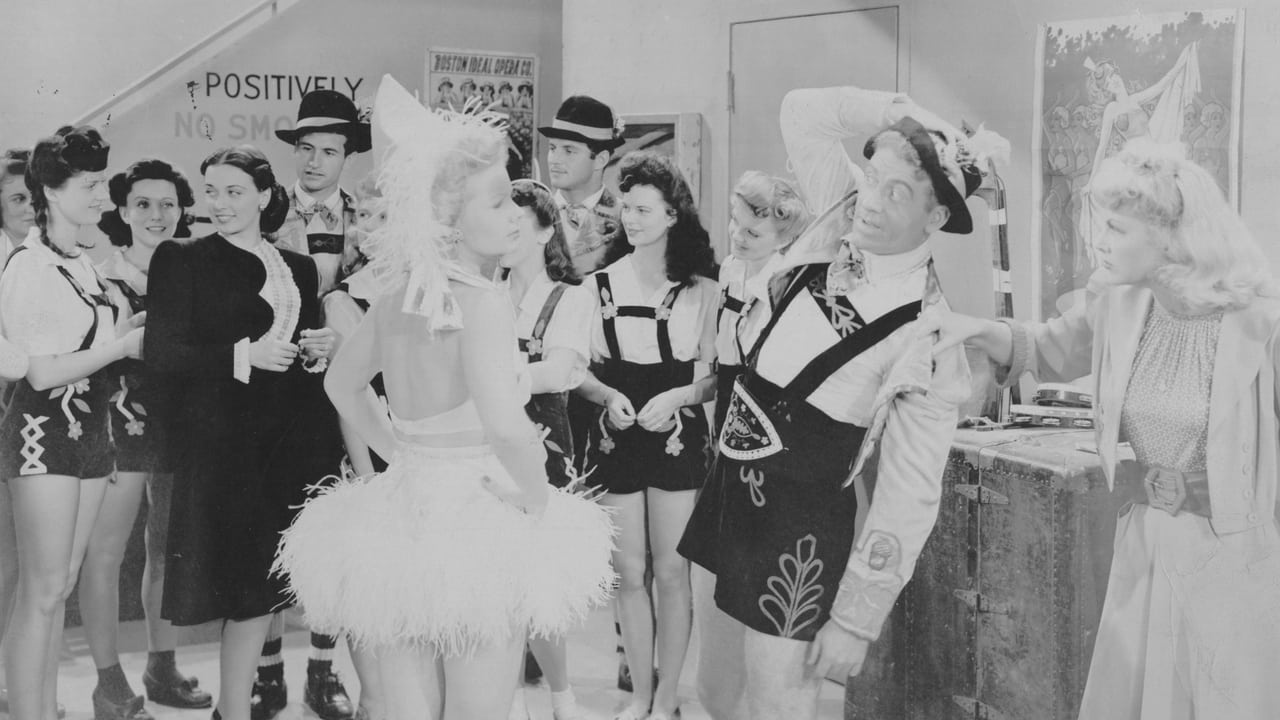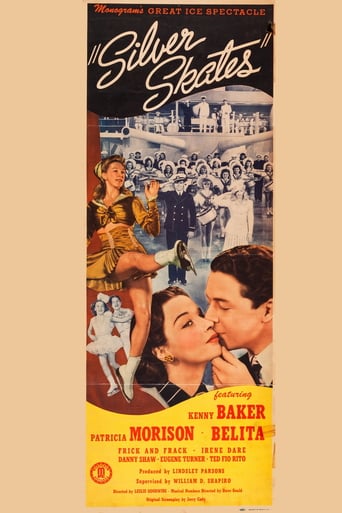

A load of bland blokes take up lots of screen time along with an annoying boy and an annoying girl who do some skating. The only reason to watch this film is for Belita. She stars as herself in a film about a company trying to keep onto her as their star attraction for their show. She skates and looks good as always but I wish she had been given a better story.If you like skating, Eugene Turner also turns up as himself and partners Belita on the ice. We have some songs thrown in – not particularly memorable but OK – and we also have the required morale-boosting ending about the Navy where everyone gets to wear a navy Captain's hat. Cool.
... View MoreSILVER SKATES (Monogram, 1943), directed by Leslie Goodwins, with entire production and supervision by Lindsay Parsons, is, by its label title, an ice skating musical, but not one starring the queen of the ice skating musicals herself, Sonja Henie. Of the films for which she appeared, Henie never had "skates" among her movie titles. Yet SILVER SKATES, which stars Kenny Baker and Patricia Morison, features Monogram's very own ice skating specialty, Belita, labeled in the opening credits as "star of the ice." While the Henie musicals produced by 20th Century-Fox centered around her mostly in plot and ice skating portions of the film, SILVER SKATES shares Belita with other specialties of the day as youngsters Irene Dare and Danny Shaw doing their own ice skating techniques, George Stuart, Eugene Turner and Jo Ann Dean playing themselves. There's also some time out antics by comedy team of Frick and Frack whose routines may have one think of the Ritz Brothers, but being no threat to that team nor any other comedy team for that matter as a result.The story, set in the Broadway district of New York City, finds Claire Thomas (Patricia Morison), producer of "Silver Skates Ice Revue," may go out of business after her star ice skating attraction, Belita (Belita) finishes her two week engagement to marry Tom (Henry Wadsworth), a Chicago businessman. Claire, who's loved by Danny Donovan (Kenny Baker), refuses to marry the singer in the show until she can clear herself of back debts. Thanks to Eddie (Frank Faylen), a stage hand, who, after receiving his two week notice, spreads a rumor that Belita secretly loves Danny, and because of that, feels that this would start of a romance that have Belita remain in the revue, thus keeping his job. During the complications which finds Danny engaged to two women at the same time, Claire encounters a little Dutch girl named Katrina (Irene Dare) in the lobby of her Broadmoor Arms apartment. It is learned that Katrina not only has gotten separated from Miss Martin (Ruth Lee) of the Netherlands Relief Commiittee, but turns out to be an orphan awaiting news about her Uncle Conrad Humperdinck, a former skater in Claire's shows. Learning Uncle Conrad has gone to serve in the Army, and her parents killed in an air raid, Claire assumes responsibility for the child with the intent on adopting her. Complications occur as Claire tries to induce Danny to marry her, only to learn about his "engagement" to Belita. Other members of the cast include the ever reliable Joyce Compton (Lucille, Eddie's girlfriend); Paul McVey (Roscoe Hayes, the booking agent); John Maxwell (Blake); Ruby Dandridge (The Maid); and Ted Fio Rito and his Orchestra.With the plot being as ordinary and secondary as forties musicals go, the song interludes, particularly the ice skating portions choreographed by Dave Gould, certainly highlight this production. With pleasing music and lyrics by David Oppenheim and Roy Ingraham, song numbers include: "Lovely Lady" (sung by Kenny Baker, skated by Belita); Dream sequence skating number with Irene Dare with Holland setting; "Cowboy Joe" (sung by chorus, skated by Danny Shaw); "Can't You Hear Me Calling From the Mountain?" (performed by Frick and Frack); "A Boy Like You, a Girl Like Me" (Sung by Kenny Baker and Patricia Morison); "Hollywood Victory Party" (skating sequence by Irene Dare and Danny Shaw); "Dancing on Top of the World" (sung by chorus, skated by Irene Dare); "Love is a Beautiful Song" (sung by Baker); and finale, "Sing a Song of the Sea" (Baker, Belita, chorus).With Monogram Pictures having a reputation of being second features of low-budget production value, SILVER SKATES comes as a surprise for anyone expecting very little. Though not quite 20th Century-Fox nor Metro-Goldwyn-Mayer, it is an interesting effort in Monogram's attempt on rising itself to better quality films. Though not quite Academy Award winning material, the film overall is an entertaining 73 minutes from its ten minute ice skating opening to grand scale final, with a little in-between amusements of amusing wisecracks and some hit and miss comedy. For anyone familiar with Patricia Morison, it's interesting finding her playing against her bad girl/ femme fatal type for decent, caring woman for a change. Her musical participation with Kenny Baker comes as a sheer reminder of the crooning style of Dick Powell and Ruby Keeler from his thirties musicals, yet something of a disappointment listening to Morison singing to an obviously dubbed vocalization. The star attraction, Belita, may not a good actress but somewhat forgivable in terms of being a newcomer to films who presents herself well enough as an agreeable new screen personality.Virtually forgotten by cast, title and reputation due to lack of television broadcasts since the 1950s or so, and never distributed to home video, SILVER SKATES was resurrected on cable TV's Turner Classic Movies in May of 1997 as part of its then monthly viewer's movie request. After that sole broadcast, it wasn't repeated again until many years later starting in October 2014. SILVER SKATES is definitely a "B" class musical regardless of its "A" production effort, but a worthy rediscovery as ice skating musicals go. (**1/2)
... View MoreMonogram offers us Belita, Monogram's answer to Sonia Henjie. Not that anyone was asking, considering that Miss Henjie was given Lucky Humberstone as a director by this time. As others have noted, Belita seems more the girl who would get what a man was driving at, and RKO's Leslie Goodwins was hired to direct this movie, so it doesn't stink on ice. However, there's not much in the way of script or good songs, and they got Kenny Baker as the young singer. He was okay in the movie version of THE MIKADO, but W.S. Gilbert never had much respect for tenors. Mr. Baker justifies his faith here as he doesn't always bother to match his lips to the words he is singing.That leaves Frick and Frack. These skating clowns have lingered in my mind, even though, so far as I know, I had never heard of them -- it seemed like the sort of name two tummelers, slapstick comedians from the Catskills would have. It turns out that's what they were, and I don't know where I know them from. Perhaps they played the Neverle one summer when I was four and I remember nothing but the funny names. They're actually pretty good.That's the best that can be said for this movie. Like most Monograms, it's fast, it doesn't strain the brain and it's over soon enough. I assume that's how the director felt, because for his next movie, he was back at the comparative luxury of RKO directing Leon Errol in "The Mexican Spitfire's Elephant".
... View MoreThe sublime, the ridiculous and the annoying all get a run in this Monogram dazzler made as a mid war morale booster. BELITA, the Brit skate star who reigned as she skated at Monogram for 5 years was an absolutely gorgeous woman, and her appearances in the musicals like this one and LADY LETS DANCE are simply sensational. Also see SUSPENSE and THE GANGSTER both also made at Monogram for a feast and a fest. She is the best thing about this musical jumble; the worst is mannequin-man and whiny singer Kenny Baker... he is so wooden and his Dagwood looks have always left me cold... colder than the slabs Belita zooms across showing us her crotch. Repeatedly.... The annoying is the haphazard production which often seemed filmed in a corner of the studio.... odd short sets that are just a corner with a door, or big production numbers in a deep narrow set. This film has a truly terrible script and a lot of forced romance. Coupled with bad acting and a remote Pat Morison as the female lead actress, SILVER SKATES only works in the terrific musical skate production numbers... fortunately there are many. Though some are oddly dressed and choreographed... skaters arrive and leave in the background without performing, some wear too many clothes, others in groups wear similar ballgowns but are a razzle of colors and patterns, so it just looks like everyone grabbed anything they could and all rushed on to the ice in a mess of every costume hanging out the back... It actually looks like a suburban church production with costumes from a charity jumble sale. In one big number, compete with santasnow, wet bedsheets, a pine tree and cardboard igloos, we have a bevy of skating chorus girls, a fab kid skater, a penguin and an seal. The penguin wanders about all through two numbers and the viewers eye is constantly distracted from the skate show to see which direction the penguin has wandered off to. At one moment a rush of skating chorus girls just crashes straight into him... and the cameras keep rolling and the poor little thing just wobbles about between their legs. No wildlife wrangler at Monogram! There are two children who skate in this film and they are equally excellent. The big finale, which for no reason is a "battleship extravaganza" features squadrons of skaters in (hooray) matching outfits... but it is filmed from another suburb... the camera is so far away from the 'big set' for a lot of the 'big moments' that we are left wondering why there is 7000 acres of wet white ice in front of the show. The closeups of BELITA and her adagio, whizz-bye-s are excellent and as always she is sexy and sensational. It actually looks like a very cheap high school version of the massive Elanor Powell number from the finale of BORN TO DANCE. But this is a Monogram Picture and as such it is their 'biggie for'43'.... and should be enjoyed as such..... but try finding reason or cohesion in the array of dance numbers of what on earth type of show would manage an excuse for the order they come in or why they are presented. The actual fun in this musical is the mish mash of it all. Then you are truly ready for their SWING PARADE OF 1946 which has a crammed jammed and flung-at-you musical finale more in common with Cole Slaw than Cole Porter.
... View More